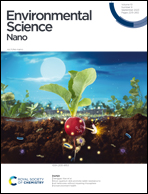Comparing the inhibitory effects of CuO-rGO, CuO NPs, and CuCl2 on the oomycete Phytophthora sojae: insights from phenotypic and transcriptomic analyses†
Abstract
Phytophthora sojae is an oomycete pathogen that causes significant agricultural losses worldwide, mainly the soybean damping-off and root/stem rot. To counter this, copper oxide nanoparticles (CuO NPs)/reduced graphene oxide (rGO) composites (CuO-rGO) have been proposed as a potential solution in nano-agriculture. In this study, we aimed to investigate the inhibitory mechanisms of CuO-rGO, CuO NPs, and CuCl2 on P. sojae through phenotypic and transcriptomic analysis. Even a low concentration of 10 mg Cu2+ L−1, CuO-rGO, CuO NPs, and CuCl2 exhibited remarkable inhibitory effects on the pathogen. This was due to the capacity of these three forms of Cu to induce oxidative stress, which caused disruptions in the mycelial cell membrane, intracellular structure, carbon metabolism, organic acid metabolic processes, and amino acid metabolism. Among them, CuO-rGO showed a better slow-release effect and long-lasting antimicrobial properties, making it more suitable for practical agricultural use. Furthermore, the transcriptomic analysis revealed distinct patterns of antioxidant enzyme-related genes among treatments. Compared to the other two treatments, the CuO-rGO treatment showed higher expression of differential expression genes (DEGs) associated with superoxide dismutase (SOD) and peroxiredoxin (PRDX). The CuO NPs treatment had the most significant expression of DEGs related to catalase (CAT), while the DEGs linked to glutathione peroxidase (GPX) were significantly expressed in the CuCl2 and CuO-rGO treatments. These findings suggest that CuO-rGO has great potential as a practical agricultural agent against oomycete pathogens. Further investigations are essential to elucidate the mechanisms underlying the oxidative stress and antioxidant systems induced by different copper forms in the future.

- This article is part of the themed collections: Environmental Science: Nano Recent HOT Articles and Nano-bio interactions


 Please wait while we load your content...
Please wait while we load your content...